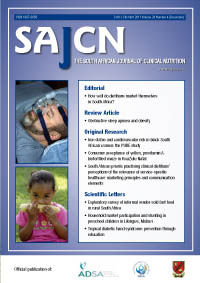Household market participation and stunting in preschool children in Lilongwe, Malawi
Keywords:
stunting, preschool children, Malawi, risk factors, agriculture
Abstract
Background: Stunting among Malawian preschool children continues to be a concern. Method: A cross-sectional survey of 251 semi-urban households, who participated in a community-supported preschool programme, was conducted. Results: Of the 433 participating two- to five-year-old children, 34.4% had stunting. Children from families who grow tobacco were less likely than other children to have stunting (27.0% vs. 37.3%, p-value = 0.04). In contrast, children from families who grow a local type of cowpea (khobwe) had a higher rate of stunting than other children (46.8% vs. 32.9%, p-value = 0.01). Conclusion: The study suggests that the increased income associated with household participation in the growing of globally marketable cash crops, as compared to the growing of local crops, may lead to increased nutritional benefits for children.
Published
2011-09-26
How to Cite
Howard, A., Komwa, M., Yohane, R., & Jacobsen, K. (2011). Household market participation and stunting in preschool children in Lilongwe, Malawi. South African Journal of Clinical Nutrition, 24(4), 202-204. Retrieved from http://sajcn.co.za/index.php/SAJCN/article/view/526
Issue
Section
Short Reports or Scientific Letters
Material submitted for publication in the South African Journal of Clinical Nutrition (SAJCN) is accepted provided it has not been published elsewhere. Copyright forms will be sent with acknowledgement of receipt and the SAJCN reserves copyright of the material published.
The SAJCN does not hold itself responsible for statements made by the authors.


